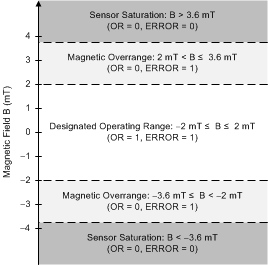-
DRV425 Fluxgate Magnetic-Field Sensor
- 1 Features
- 2 Applications
- 3 Description
- 4 Revision History
- 5 Pin Configuration and Functions
- 6 Specifications
- 7 Detailed Description
- 8 Application and Implementation
- 9 Power-Supply Recommendations
- 10Layout
- 11Device and Documentation Support
- 12Mechanical, Packaging, and Orderable Information
- IMPORTANT NOTICE
DRV425 Fluxgate Magnetic-Field Sensor
1 Features
- High-Precision, Integrated Fluxgate Sensor:
- Offset: ±8 µT (Max)
- Offset Drift: ±5 nT/°C (Typ)
- Gain Error: 0.04% (Typ)
- Gain Drift: ±7 ppm/°C (Typ)
- Linearity: ±0.1%
- Noise: 1.5 nT/√Hz (Typ)
- Sensor Range: ±2 mT (Max)
- Range and Gain Adjustable with External Resistor
- Selectable Bandwidth: 47 kHz or 32 kHz
- Precision Reference:
- Accuracy: 2% (max), Drift: 50 ppm/°C (max)
- Pin-Selectable Voltage: 2.5 V or 1.65 V
- Selectable Ratiometric Mode: VDD / 2
- Diagnostic Features: Overrange and Error Flags
- Supply Voltage Range: 3.0 V to 5.5 V
2 Applications
3 Description
The DRV425 is designed for single-axis magnetic field-sensing applications and enables electrically-isolated, high-sensitivity, and precise dc- and ac-field measurements. The device provides the unique and proprietary, integrated fluxgate sensor (IFG) with an internal compensation coil to support a high-accuracy sensing range of ±2 mT with a measurement bandwidth of up to 47 kHz. The low offset, offset drift, and noise of the sensor, combined with the precise gain, low gain drift, and very low nonlinearity provided by the internal compensation coil, result in unrivaled magnetic field measurement precision. The output of the DRV425 is an analog signal proportional to the sensed magnetic field.
The DRV425 offers a complete set of features, including an internal difference amplifier, on-chip precision reference, and diagnostic functions to minimize component count and system-level cost.
The DRV425 is available in a thermally-enhanced, non-magnetic, thin WQFN package with a PowerPAD™ for optimized heat dissipation, and is specified for operation over the extended industrial temperature range of –40°C to +125°C.
Device Information (1)
| PART NUMBER | PACKAGE | BODY SIZE (NOM) |
|---|---|---|
| DRV425 | WQFN (20) | 4.00 mm × 4.00 mm |
- For all available packages, see the orderable addendum at the end of the data sheet.
Simplified Schematic

5 Pin Configuration and Functions

Pin Functions
| PIN | I/O | DESCRIPTION | |
|---|---|---|---|
| NAME | NO. | ||
| AINN | 14 | I | Inverting input of the shunt-sense amplifier |
| AINP | 13 | I | Noninverting input of the shunt-sense amplifier |
| BSEL | 1 | I | Filter bandwidth select input |
| COMP1 | 16 | I | Internal compensation coil input 1 |
| COMP2 | 17 | I | Internal compensation coil input 2 |
| DRV1 | 12 | O | Compensation coil driver output 1 |
| DRV2 | 11 | O | Compensation coil driver output 2 |
| ERROR | 19 | O | Error flag: open-drain, active-low output |
| GND | 7, 10, 18, 20 | — | Ground reference |
| OR | 15 | O | Shunt-sense amplifier overrange indicator: open-drain, active-low output |
| PowerPAD | — | Connect the thermal pad to GND | |
| REFIN | 5 | I | Common-mode reference input for the shunt-sense amplifier |
| REFOUT | 4 | O | Voltage reference output |
| RSEL0 | 3 | I | Voltage reference mode selection input 0 |
| RSEL1 | 2 | I | Voltage reference mode selection input 1 |
| VDD | 8, 9 | — | Supply voltage, 3.0 V to 5.5 V. Decouple both pins using 1-µF ceramic capacitors placed as close as possible to the device. See the Power-Supply Decoupling and Layout sections for further details. |
| VOUT | 6 | O | Shunt-sense amplifier output |
6 Specifications
6.1 Absolute Maximum Ratings
over operating free-air temperature range (unless otherwise noted)(1)| MIN | MAX | UNIT | ||
|---|---|---|---|---|
| Voltage | Supply voltage (VDD to GND) | –0.3 | 6.5 | V |
| Input voltage, except AINP and AINN pins(2) | GND – 0.5 | VDD + 0.5 | ||
| Shunt-sense amplifier inputs (AINP and AINN pins)(3) | GND – 6.0 | VDD + 6.0 | ||
| Current | DRV1 and DRV2 pins (short-circuit current, IOS)(4) | –300 | 300 | mA |
| Shunt-sense amplifier input pins AINP and AINN | –5 | 5 | ||
| All remaining pins | –25 | 25 | ||
| Temperature | Junction, TJ max | –50 | 150 | °C |
| Storage, Tstg | –65 | 150 | ||
6.2 ESD Ratings
| VALUE | UNIT | |||
|---|---|---|---|---|
| V(ESD) | Electrostatic discharge | Human-body model (HBM), per ANSI/ESDA/JEDEC JS-001(1) | ±2000 | V |
| Charged-device model (CDM), per JEDEC specification JESD22-C101(2) | ±1000 | |||
6.3 Recommended Operating Conditions
over operating free-air temperature range (unless otherwise noted)| MIN | NOM | MAX | UNIT | ||
|---|---|---|---|---|---|
| VDD | Supply voltage range (VDD to GND) | 3.0 | 5.0 | 5.5 | V |
| TA | Specified ambient temperature range | –40 | 125 | °C | |
6.4 Thermal Information
| THERMAL METRIC(1) | DRV425 | UNIT | |
|---|---|---|---|
| RTJ (WQFN) | |||
| 20 PINS | |||
| RθJA | Junction-to-ambient thermal resistance | 34.1 | °C/W |
| RθJC(top) | Junction-to-case (top) thermal resistance | 33.1 | °C/W |
| RθJB | Junction-to-board thermal resistance | 11 | °C/W |
| ψJT | Junction-to-top characterization parameter | 0.3 | °C/W |
| ψJB | Junction-to-board characterization parameter | 11 | °C/W |
| RθJC(bot) | Junction-to-case (bottom) thermal resistance | 2.1 | °C/W |
6.5 Electrical Characteristics
All minimum and maximum specifications are at TA = 25°C, VDD = 3.0 V to 5.5 V, and IDRV1 = IDRV2 = 0 mA, unless otherwise noted. Typical values are at VDD = 5.0 V.| PARAMETER | TEST CONDITIONS | MIN | TYP | MAX | UNIT | ||
|---|---|---|---|---|---|---|---|
| FLUXGATE SENSOR FRONT-END | |||||||
| Offset | No magnetic field | –8 | ±2 | 8 | µT | ||
| Offset drift | No magnetic field | ±5 | nT/°C | ||||
| G | Gain | Current at DRV1 and DRV2 outputs | 12.2 | mA/mT | |||
| Gain error | ±0.04% | ||||||
| Gain drift | Best-fit line method | ±7 | ppm/°C | ||||
| Linearity error | 0.1% | ||||||
| Hysteresis | Magnetic field sweep from –10 mT to 10 mT | 1.4 | µT | ||||
| Noise | f = 0.1 Hz to 10 Hz | 17 | nTrms | ||||
| Noise density | f = 1 kHz | 1.5 | nT/√Hz | ||||
| Compensation range | –2 | 2 | mT | ||||
| Saturation trip level for the ERROR pin(2) |
Open-loop, uncompensated field | 1.6 | mT | ||||
| ERROR delay | Open-loop at B > 1.6 mT | 4 to 6 | µs | ||||
| BW | Bandwidth | BSEL = 0, RSHUNT = 22 Ω | 32 | kHz | |||
| BSEL = 1, RSHUNT = 22 Ω | 47 | ||||||
| IOS | Short-circuit current | VDD = 5 V | 250 | mA | |||
| VDD = 3.3 V | 150 | ||||||
| Common-mode output voltage at the DRV1 and DRV2 pins | VREFOUT | V | |||||
| Compensation coil resistance | 100 | Ω | |||||
| SHUNT-SENSE AMPLIFIER | |||||||
| VOO | Output offset voltage | VAINP = VAINN = VREFIN, VDD = 3.0 V | –0.075 | ±0.01 | 0.075 | mV | |
| Output offset voltage drift | –2 | ±0.4 | 2 | µV/°C | |||
| CMRR | Common-mode rejection ratio, RTO(1) | VCM = –1 V to VDD + 1 V, VREFIN = VDD / 2 | –250 | ±50 | 250 | µV/V | |
| PSRRAMP | Power-supply rejection ratio, RTO(1) | VDD = 3.0 V to 5.5 V, VCM = VREFIN | –50 | ±4 | 50 | µV/V | |
| VICR | Common-mode input voltage range | –1 | VDD + 1 | V | |||
| zid | Differential input impedance | 16.5 | 20 | 23.5 | kΩ | ||
| zic | Common-mode input impedance | 40 | 50 | 60 | kΩ | ||
| Gnom | Nominal gain | VVOUT / (VAINP – VAINN) | 4 | V/V | |||
| EG | Gain error | –0.3% | ±0.02% | 0.3% | |||
| Gain error drift | –5 | ±1 | 5 | ppm/°C | |||
| Linearity error | 12 | ppm | |||||
| Voltage output swing from negative rail (OR pin trip level)(2) | VDD = 5.5 V, IVOUT = 2.5 mA | 48 | 85 | mV | |||
| VDD = 3.0 V, IVOUT = 2.5 mA | 56 | 100 | |||||
| Voltage output swing from positive rail (OR pin trip level)(2) | VDD = 5.5 V, IVOUT = –2.5 mA | VDD – 85 | VDD – 48 | mV | |||
| VDD = 3.0 V, IVOUT = –2.5 mA | VDD – 100 | VDD – 56 | |||||
| Signal overrange indication delay (OR pin)(2) |
VIN = 1-V step | 2.5 to 3.5 | µs | ||||
| IOS | Short-circuit current | VOUT connected to GND | –18 | mA | |||
| VOUT connected to VDD | 20 | ||||||
| BW–3dB | Bandwidth | 2 | MHz | ||||
| SR | Slew rate | 6.5 | V/µs | ||||
| tsa | Settling time | Large signal | ΔV = ± 2 V to 1%, no external filter | 0.9 | µs | ||
| Small signal | ΔV = ± 0.4 V to 0.01% | 8 | |||||
| en | Output voltage noise density | f = 1 kHz, compensation loop disabled | 170 | nV/√Hz | |||
| VREFIN | Input voltage range at pin REFIN | Input voltage range at REFIN pin | GND | VDD | V | ||
| VOLTAGE REFERENCE | |||||||
| VREFOUT | Reference output voltage at the REFOUT pin | RSEL[1:0] = 00, no load | 2.45 | 2.5 | 2.55 | V | |
| RSEL[1:0] = 01, no load | 1.6 | 1.65 | 1.7 | ||||
| RSEL[1:0] = 1x, no load | 45 | 50 | 55 | % of VDD | |||
| Reference output voltage drift | RSEL[1:0] = 0x | –50 | ±10 | 50 | ppm/°C | ||
| Voltage divider gain error drift | RSEL[1:0] = 1x | –50 | ±10 | 50 | ppm/°C | ||
| PSRRREF | Power-supply rejection ratio | RSEL[1:0] = 0x | –300 | ±15 | 300 | µV/V | |
| ΔVO(ΔIO) | Load regulation | RSEL[1:0] = 0x, load to GND or VDD, ΔILOAD = 0 mA to 5 mA, TA = –40°C to +125°C |
0.15 | 0.35 | mV/mA | ||
| RSEL[1:0] = 1x, load to GND or VDD, ΔILOAD = 0 mA to 5 mA, TA = –40°C to +125°C |
0.3 | 0.8 | |||||
| IOS | Short-circuit current | REFOUT connected to VDD | 20 | mA | |||
| REFOUT connected to GND | –18 | mA | |||||
| DIGITAL INPUTS/OUTPUTS (CMOS) | |||||||
| IIL | Input leakage current | 0.01 | µA | ||||
| VIH | High-level input voltage | TA = –40°C to +125°C | 0.7 × VDD | VDD + 0.3 | V | ||
| VIL | Low-level input voltage | TA = –40°C to +125°C | –0.3 | 0.3 × VDD | V | ||
| VOH | High-level output voltage | Open-drain output | Set by external pullup resistor | V | |||
| VOL | Low-level output voltage | 4-mA sink current | 0.3 | V | |||
| POWER SUPPLY | |||||||
| IQ | Quiescent current | IDRV1/2 = 0 mA, 3.0 V ≤ VDD ≤ 3.6 V, TA = –40°C to +125°C |
6 | 8 | mA | ||
| IDRV1/2 = 0 mA, 4.5 V ≤ VDD ≤ 5.5 V, TA = –40°C to +125°C |
7 | 10 | |||||
| VPOR | Power-on reset threshold | 2.4 | V | ||||
6.6 Typical Characteristics
at VDD = 5 V and TA = 25°C (unless otherwise noted)
| VDD = 5 V |

Supply Voltage


Supply Voltage

| VDD = 5 V |


| VDD = 5 V |
Trip Level Histogram



| VDD = 3.3 V |


Input Signal Frequency

Ripple Frequency

vs Temperature

vs Temperature

| Including IFG, VDD = 3.3 V |

Input Signal Frequency




| Rising edge |
Settling Time

| Rising edge |
Settling Time

| VDD = 5 V |


| VREFOUT = 1.65 V |






| VDD = 3.3 V |

Temperature

| VDD = 5 V |


Supply Voltage


| VDD = 3.3 V |
Trip Level Histogram


| VDD = 5 V |

Supply Voltage





| Including IFG, VDD = 5 V |

Temperature

Supply Voltage




| Falling edge |
Settling Time

| Falling edge |
Settling Time

| VDD = 3.3 V |

| VREFOUT = 2.5 V |






7 Detailed Description
7.1 Overview
Magnetic sensors are used in a broad range of applications (such as position, indirect ac and dc current, or torque measurement). Hall-effect sensors are most common in magnetic field sensing, but their offset, noise, gain variation, and nonlinearity limit the achievable resolution and accuracy of the system. Fluxgate sensors offer significantly higher sensitivity, lower drift, lower noise, and high linearity and enable up to 1000-times better accuracy of the measurement.
As shown in the Functional Block Diagram section, the DRV425 consists of a magnetic fluxgate sensor with the necessary sensor conditioning and compensation coil to internally close the control loop. The fluxgate sensor is repeatedly driven in and out of saturation and supports hysteresis-free operation with excellent accuracy. The internal compensation coil assures stable gain and high linearity.
The magnetic field (B) is detected by the internal fluxgate sensor in the DRV425. The device integrates the sensor output to assure high-loop gain. The integrator output connects to the built-in differential driver that drives an opposing compensation current through the internal compensation coil. The compensation coil generates an opposite magnetic field that brings the original magnetic field at the sensor back to zero.
The compensation current is proportional to the external magnetic field and its value is 12.2 mA/mT. This compensation current generates a voltage drop across an external shunt resistor, RSHUNT. An integrated difference amplifier with a fixed gain of 4 V/V measures this voltage and generates an output voltage that is referenced to REFIN and is proportional to the magnetic field. The value of the output voltage at the VOUT pin (VVOUT) is calculated using Equation 1:
7.2 Functional Block Diagram
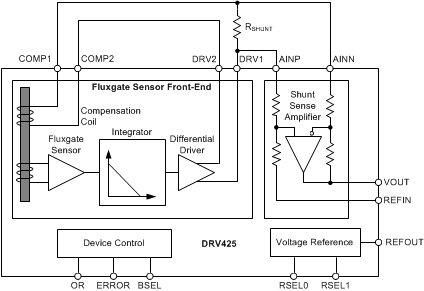
7.3 Feature Description
7.3.1 Fluxgate Sensor Front-End
The following sections describe the functional blocks and features of the integrated fluxgate sensor front-end.
7.3.1.1 Fluxgate Sensor
The fluxgate sensor of the DRV425 is uniquely suited for high-performance magnetic-field sensors because of the high sensitivity, low noise, and low offset of the sensor. The fluxgate principle relies on repeatedly driving the sensor in and out of saturation; therefore, the sensor is free of any significant magnetic hysteresis. The feedback loop accurately drives a compensation current through the integrated compensation coil and drives the magnetic field at the sensor back to zero. This approach supports excellent gain stability and high linearity of the measurement.
The DRV425 package is free of any ferromagnetic materials in order to prevent magnetization by external fields and to obtain accurate and hysteresis-free operation. Select non-magnetizable materials for the printed circuit board (PCB) and passive components in the direct vicinity of the DRV425; see the Layout Guidelines section for more details.
The orientation and the sensitivity axis of the fluxgate sensor is indicated by a dashed line on the top of the package, as shown in Figure 61. Figure 61 also shows the location of the sensor inside the package.
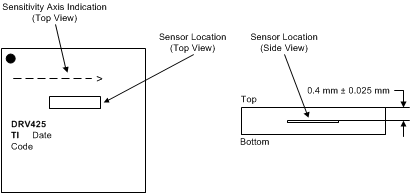 Figure 61. Magnetic Sensitivity Direction of the Integrated Fluxgate Sensor
Figure 61. Magnetic Sensitivity Direction of the Integrated Fluxgate Sensor
The sensitivity of the fluxgate sensor is a vector function of its sensitivity axis and the magnetic field orientation. Figure 62 shows the output of the DRV425 in dependency of the orientation of the device to a constant magnetic field.
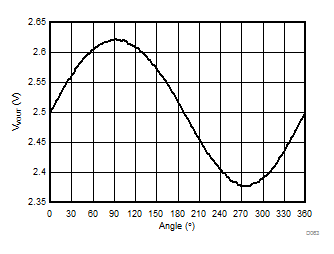
7.3.1.2 Bandwidth
The small-signal bandwidth of the DRV425 is determined by the behavior of the compensation loop versus frequency. The implemented integrator limits the bandwidth of the loop to provide stable response. Use the digital input pin BSEL to select the bandwidth. For a shunt resistor of 22 Ω and BSEL = 0, the bandwidth is 32 kHz; for BSEL = 1, the bandwidth is 47 kHz.
Bandwidth can be reduced by increasing the value of the shunt resistor because the shunt resistor and the compensation coil resistance form a voltage divider. The reduced bandwidth (BW) can be calculated using Equation 2:

where
- RCOIL = internal compensation coil resistance (100 Ω),
- RSHUNT = external shunt resistance, and
- BW22Ω = sensor bandwidth with RSHUNT = 22 Ω (depending on the BSEL setting)
The bandwidth for a given shunt resistor value can also be calculated using the DRV425 System Parameter Calculator, SLOC331. For large magnetic fields (B > 500 μT), the effective bandwidth of the sensor is limited by fluxgate saturation effects. For a magnetic signal with a 2-mT amplitude, the large-signal bandwidth is 10 kHz with BSEL = 0 or 15 kHz with BSEL = 1.
Although the analog output responds slowly to large fields, a magnetic field with a magnitude of 1.6 mT (or higher) beyond the measurement range of the DRV425 triggers the ERROR pin within 4 µs to 6 µs. See the Magnetic Field Range, Overrange Indicator, and Error Flag section for more details.
7.3.1.3 Differential Driver for the Internal Compensation Coil
The differential compensation coil driver provides the current for the internal compensation coil at the DRV1 and DRV2 pins. The driver is capable of sourcing up to ±250 mA with a 5-V supply or up to ±150 mA in 3.3-V mode. The current capability is not internally limited. The actual value of the compensation coil current depends on the magnetic field strength and is limited by the sum of the resistance of the internal compensation coil and the external shunt resistor value. The internal compensation coil resistance depends on temperature (see Figure 17) and must be taken into account when dimensioning the system. Select the value of the shunt resistor to avoid OR pin trip levels in normal operation.
The common-mode voltage of the compensation coil driver outputs is set by the RSEL pins (see the Voltage Reference section). Thus, the common-mode voltage of the shunt-sense amplifier is matched if the internal reference is used.
Consider the polarity of the compensation coil connection to the output of the compensation coil driver. If the polarity is incorrect, then the driver output drives to the power-supply rails, even at low primary-current levels. In this case, interchange the connection of the DRV1 and DRV2 pins to the compensation coil.
7.3.1.4 Magnetic Field Range, Overrange Indicator, and Error Flag
The measurement range of the DRV425 is determined by the amount of current driven into the compensation coil and the output voltage range of the shunt-sense amplifier. The maximum compensation current is limited by the supply voltage and the series resistance of the compensation coil and the shunt.
The magnetic field range is adjusted with the external shunt resistor. The DRV425 System Parameter Calculator, SLOC331 provides the maximum shunt resistor values depending on the supply voltage (VDD) and the selected reference voltage (VREFIN) for various magnetic field ranges.
For proper operation at a maximum field (BMAX), choose a shunt resistor (RSHUNT) using Equation 3

where
- VDD = minimum supply voltage of the DRV425 (V),
- VREFIN = common-mode voltage of the shunt-sense amplifier (V), and
- BMAX = desired magnetic field range (T)
Alternatively, to adjust the output voltage of the DRV425 for a desired maximum voltage (VVOUTMAX), use Equation 4:

where
- VVOUTMAX = desired maximum output voltage at VOUT pin (V), and
- BMAX = desired magnetic field range (T)
To avoid railing of the compensation coil driver, assure that Equation 5 is fulfilled:

where
- BMAX = desired magnetic field range (T),
- RCOIL = compensation coil resistance (Ω),
- VDD = minimum supply voltage of the DRV425 (V), and
- VREFIN = selected internal reference voltage value (V)
The DRV425 System Parameter Calculator, SLOC331 is designed to assist with selecting the system parameters.
The DRV425 offers two diagnostic output pins to detect large fields that exceed the measurement range of the sensor: the overrange indicator (OR) and the ERROR flag.
In normal operation, the DRV425 sensor feedback loop compensates the magnetic field inside the fluxgate to zero. Therefore, a large field inside the fluxgate indicates that the feedback loop is not properly working and the sensor output is invalid. To detect this condition, the ERROR pin is pulled low if the internal field exceeds 1.6 mT. The ERROR output is suppressed for 4 µs to 6 µs to prevent an undesired reaction to transients or noise. For static and slowly varying ambient fields, the ERROR pin triggers when the ambient field exceeds the sensor measurement range by more than 1.6 mT. For dynamic magnetic fields that exceed the sensor bandwidth as specified in the Specifications section, the feedback loop response is too slow to accurately compensate the internal field to zero. Therefore, high-frequency fields can trigger the ERROR pin, even if the ambient field does not exceed the measurement range by 1.6 mT.
In addition, the low-active overrange pin (OR) indicates railing of the output of the shunt-sense amplifier. The OR output is suppressed for 2.5 µs to 3.5 µs to prevent an undesired reaction to transients or noise. The OR pin trip level refers to the output voltage value of the shunt-sense amplifier as specified in the Specifications section. Use Equation 3 and Equation 4 to adjust the OR pin behavior to the specific system-level requirements.
Both the ERROR and OR pins are open-drain outputs that require an external pullup resistor. Connect both pins together with a single pullup resistor to provide a single diagnostic flag, if desired.
Based on the DRV425 System Parameter Calculator, SLOC331, for a design for a ±2-mT magnetic field input range with a supply of 5 V (±5%), a shunt resistor value of 22 Ω is selected and Figure 63 shows the status of the diagnostic flags in the resulting three operation ranges.
With the proper RSHUNT value, the differential amplifier output rails and activates the overrange flag (OR = 0) when the magnetic field exceeds the designated operating range. For fields that exceed the measurement range of the DRV425 by ≥ 1.6 mT, the fluxgate is permanently saturated and the ERROR pin is pulled low. In this condition, the fluxgate sensor does not provide a valid output value and, therefore, the output VOUT of the DRV425 must be ignored. In applications where the ERROR pin cannot be separately monitored, combining the VOUT and ERROR outputs is recommended (as shown in Figure 64) to indicate a magnetic field outside of the sensor range by pulling the output of the DRV425 to ground.
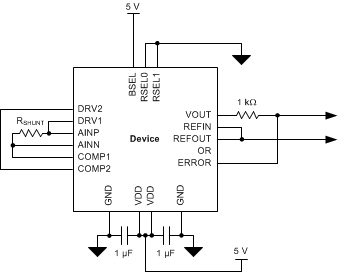 Figure 64. Field Overrange Detection Using a Combined VOUT and ERROR Pin
Figure 64. Field Overrange Detection Using a Combined VOUT and ERROR Pin
7.3.2 Shunt-Sense Amplifier
The compensation coil current creates a voltage drop across the external shunt resistor, RSHUNT. The internal differential amplifier senses this voltage drop. This differential amplifier offers wide bandwidth and a high slew rate. Excellent dc stability and accuracy result from a chopping technique. The voltage gain is 4 V/V, set by precisely-matched and thermally-stable internal resistors.
Both the AINN and AINP differential amplifier inputs are connected to the external shunt resistor. This shunt resistor, in series with the internal 10-kΩ input resistors of the shunt sense amplifier, causes an additional gain error. Therefore, for best common-mode rejection performance, place a dummy shunt resistor (R5) with a value higher than the shunt resistor in series with the REFIN pin to restore the matching of both resistor dividers, as shown in Figure 65.
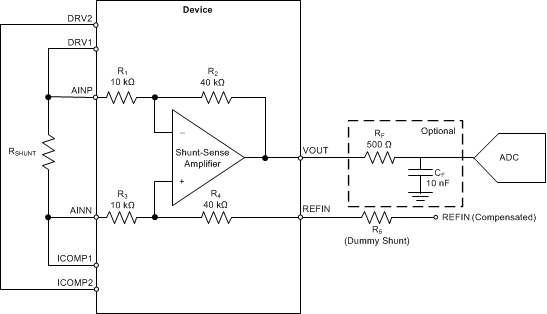 Figure 65. Internal Difference Amplifier with an Example of a Decoupling Filter
Figure 65. Internal Difference Amplifier with an Example of a Decoupling Filter
For an overall gain of 4 V/V, calculate the value of R5 using Equation 6:

where
- R2 / R1 = R4 / R3 = 4,
- R5 = RSHUNT × 4
If the input signal is large, the amplifier output drives close to the supply rails. The amplifier output is able to drive the input of a successive approximation register (SAR) analog-to-digital converter (ADC). For best performance, add an RC low-pass filter stage between the shunt-sense amplifier output and the ADC input. This filter limits the noise bandwidth and decouples the high-frequency sampling noise of the ADC input from the amplifier output. For filter resistor RF and filter capacitor CF values, see the specific converter recommendations in the respective product data sheet.
The shunt-sense amplifier output drives 100 pF directly and shows a 50% overshoot with a 1-nF capacitance. Filter resistor RF extends the capacitive load range. Note that with an RF of only 20 Ω, the load capacitor must be either less than 1 nF or more than 33 nF to avoid overshoot; with an RF of 50 Ω, this transient area is avoided.
Reference input REFIN is the common-mode voltage node for the output signal VOUT. Use the internal voltage reference of the DRV425 by connecting the REFIN pin to the reference output REFOUT. To avoid mismatch errors, use the same reference voltage for REFIN and the ADC. Alternatively, use an ADC with a pseudo-differential input, with the positive input of the ADC connected to VOUT and the negative input connected to REFIN of the DRV425.
7.3.3 Voltage Reference
The internal precision voltage reference circuit offers low-drift performance at the REFOUT output pin and is used for internal biasing. The reference output is intended to be the common-mode voltage of the output (the VOUT pin) to provide a bipolar signal swing. This low-impedance output tolerates sink and source currents of ±5 mA. However, fast load transients can generate ringing on this line. A small series resistor of a few ohms improves the response, particularly for capacitive loads equal to or greater than 1 μF.
Adjust the value of the voltage reference output to the power supply of the DRV425 using mode selection pins RSEL0 and RSEL1, as shown in Table 1.
Table 1. Reference Output Voltage Selection
| MODE | RSEL1 | RSEL0 | DESCRIPTION |
|---|---|---|---|
| VREFOUT = 2.5 V | 0 | 0 | Use with a sensor module supply of 5 V |
| VREFOUT = 1.65 V | 0 | 1 | Use with a sensor module supply of 3.3 V |
| Ratiometric output | 1 | x | Provides an output centered on VDD / 2 |
In ratiometric output mode, an internal resistor divider divides the power-supply voltage by a factor of two.
7.3.4 Low-Power Operation of the DRV425
In applications with low-bandwidth or low sample-rate requirements, the average power dissipation of the DRV425 can be significantly reduced by powering the device down between measurements. The DRV425 requires 300 μs to fully settle the analog output VOUT, as shown in Figure 66. To minimize power dissipation, the device can be powered down immediately after acquiring the sample by the ADC.
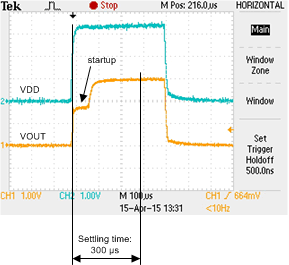 Figure 66. Settling Time of the DRV425 Output VOUT
Figure 66. Settling Time of the DRV425 Output VOUT
7.4 Device Functional Modes
The DRV425 is operational when the power supply VDD is applied, as specified in the Specifications section. The DRV425 has no additional functional modes.
